MONDAY, APRIL 28, 2025
The contract was ratified, but interest in instructor equity should remain

Student-run theater group The Pocket Playhouse performs “The Actor Games”


MONDAY, APRIL 28, 2025
The contract was ratified, but interest in instructor equity should remain

Student-run theater group The Pocket Playhouse performs “The Actor Games”



As Oregon’s police accreditation mandate nears, experts question the neutrality of the Northwest Accreditation Alliance’s law enforcement-heavy board. Eugene police defend the process, but critics say greater NWAA board independence could improve accountability.
By Lucas Hellberg City News Reporter
Earlier this year, the Eugene Police Department was reaccredited by the Northwest Accreditation Alliance, an Oregon-based nonprofit that accredits 60 police agencies in Oregon and four in Alaska. Eugene police officials said the department has been accredited by NWAA since 2015.
Police Accreditation Required by Oregon Law
Under an Oregon law passed in 2021, police agencies with more than 100 sworn officers are required to be accredited by a body designated by the Department of Public Safety Standards and Training by July 1, 2025.Currently, the NWAA and the Virginia-based Commission on Accreditation for Law Enforcement Agencies are the only designated accrediting bodies. Police Accreditation Board Independence
One difference between NWAA and CALEA is the composition of their boards. Most of NWAA’s 24-member board consists of former or current law enforcement officers in Oregon.
NWAA Executive Director Scott Hayes said that steps are in place to address conflicts of interest that board members might have. If board members are voting on the accreditation of agencies that they are currently employed by, Hayes said that they will abstain from voting.
CALEA’s 21-member board is more independent than NWAA’s. Evelen board members currently work or are retired from work in law enforcement; the rest come from other sectors. Those 10 board members include current and former municipal administrators, a criminology professor, a state senator, a circuit court judge and a county attorney. University of Texas Public Affairs Assistant Pro-





*Saleruns4/26–5/30/25.Noadditionaldiscountsorcouponsapply.Someadditionalexclusionsmayapply—seeUODuckstore.com/discountsfordetails.
EDITOR IN CHIEF
Tristin Hoffman
PRINT MANAGING EDITOR
Mathias Lehman-Winters
DIGITAL MANAGING EDITOR
Alicia Santiago
CAMPUS NEWS EDITOR
Jasmine Saboorian
CITY NEWS EDITOR
Mathias Lehman-Winters
INVESTIGATIONS EDITOR
Tarek Anthony
A&C EDITOR
Jess McComb
SPORTS EDITOR
Brady Ruth
OPINION EDITOR
Beatrice Byrd
PHOTO EDITOR
Molly McPherson
COPY CHIEF
Olivia Ellerbruch
COPY EDITOR
Alex Woodward
VIDEO EDITOR
Kendall Baldwin
PODCAST EDITOR
Evan Giordano
SOCIALS EDITOR
Sydney Wolfe
VISUALS EDITOR
Noa Schwartz
DESIGN EDITOR
Sam Butler
DESIGNERS
Adaleah Carman
Gabriela Martinez Contreras
Ash Frieswyk
Taylor Grace
Olivia Hoskinson
PUBLISHER AND PRESIDENT
Eric Henry (X317) ehenry@dailyemerald.com
VP OPERATIONS
Kathy Carbone (X302) kcarbone@dailyemerald.com
DIRECTOR OF SALES & DIGITAL MARKETING
Shelly Rondestvedt (X303) srondestvedt@dailyemerald. com
CREATIVE & TECHNICAL DIRECTOR
Anna Smith (X327) creative@dailyemerald.com
STUDENT SALES MANAGER Lola Tagwerker
ACCOUNT EXECUTIVES
Cooper Gast Elliot Byrne Ysai Hong Nate Ghilarducci
The Daily Emerald is published by Emerald Media Group, Inc., the independent nonprofit media company at the University of Oregon. Formerly the Oregon Daily Emerald, the news organization was founded in 1900.
How the annual HOPES Conference continues to explore local sustainable solutions across disciplines on its 30th anniversary
By Cass Morrison Arts & Culture Writer
On Thursday, April 10, Elise O’Brien, the graduate director of the HOPES Conference, stood before a dimly lit lecture hall for the event’s introductory panel. For the 30th anniversary of the event, attendees’ ages ranged broadly, including many conference alumni.
Founded in 1994, HOPES began with a small group of architecture and design students inspired by a collective of law students adamantly committed to sustainable causes. After hours of debate, the group decided that “Holistic Options for Planet Earth Sustainability,” or HOPES, captured their ambition. As the designers of the future, the group sought the wisdom necessary to create ecologically sustainable systems.
The original members of the conference believed that their responsibility as creators would be to design a better world, counteracting geopolitical neglect of the environment. Thirty years later, O’Brien’s introductory speech echoed the same mission.
Local conservation group confronts stormwater, pollution and cleaning up the Willamette
By Cass Morrison Arts & Culture Writer
Emerald Media Group 1395 University St.,#302 Eugene, Or 97403 (541)-346-5511

At first glance, the Willamette River flows smoothly through Eugene, a scenic stretch of water often seen as the city’s natural heart. But to Michelle Emmons, co-executive director of Willamette Riverkeeper, what lies beneath the surface tells a very different story.
“The biggest issue the Eugene area is dealing with is urban stormwater,” Emmons said. “And that’s not just runoff from the streets—it carries oil, heavy metals, microplastics, and other debris into the river.”


Three of four University of Oregon students whose visas were revoked on “unspecified criminal charges” have now been reinstated. Final visas are expected to be reactivated soon.
By Jasmine Saboorian Campus News Editor
As of noon today, three of four University of Oregon students who have had their student visas revoked have officially been reinstated, with the remaining student’s visa status expected to be reinstated as part of federal action, according to UO Spokesperson Eric Howald.
On March 28, one UO student’s visa was revoked for “unspecified criminal charges.” On April 8, The Daily Emerald reported that three additional students’ visas were revoked for the same reason. However, The Emerald later learned that one of those students, who goes by Jane Doe due to ongoing litigation, had her visa revoked on April 4.
Doe’s visa was revoked because of 2019 criminal charges that were later dropped the same year.
The Emerald was unable to verify any specific criminal charges against the remaining three students.
“Since that time, and with the help of outside legal counsel, all four students have found pathways to remain in the U.S. legally. Additionally, as of noon on April 25, three students have had their visas reactivated, one via legal action,” Howald said in an email statement to The Emerald.
According to Howald, the federal government revoked the visa status of students who appeared in criminal records checks, but did not do further research into the allegations of the students’ involvement.
The students who were employed by the university will now also be able to resume work, according to Howald.
“The university will continue to communicate with students, faculty and staff as concerns rise,” Howald said. “This ensures the affected students and communities will receive timely information from someone with expertise and previously established relationships.”

By Angelina Handris Campus News Reporter
Kindle will serve as University of Oregon’s Vice President for Enrollment Management beginning this summer
provost for enrollment management in 2020,” Kindle said.
On April 10, University of Oregon President John Karl Scholz sent out an email statement addressed to the UO community regarding the university’s selection of Derek Kindle as UO’s Vice President of Enrollment Management.
Kindle, who currently serves as Vice Provost of Enrollment Management at University of Wisconsin-Madison, hails from a small town in North Carolina. Kindle earned both his bachelor’s and master’s degrees at Howard University in Washington, D.C.
Kindle’s tenure at UO will begin on June 30. He is succeeding Roger Thompson, who held the position until July 19, 2024.
“(Howard University is) also where I entered the enrollment profession, working in several units,” Kindle said in an email statement to the Daily Emerald. “I spent nearly 16 years in Washington, D.C., at my alma mater before moving to Madison, Wisconsin, in 2016, where I first served as director of student financial aid before becoming the vice
According to Kindle, his roles include working with the Student Services and Enrollment Management team, the UO campus and community partners to support students.
“Our team’s goal is to attract the most talented students in Oregon and beyond and to provide them with support services that complement their academic and student experience,” Kindle said.
The statement sent by Scholz detailed Kindle’s previous achievements at UW-Madison, which included increasing prospective student applications by 68% and raising roughly $93.5 million for diversity recruitment endeavors.
Kindle said that some of his current goals for his time at UO are working on “key” parts of UO’s Oregon Rising plan.
“I believe the University of Oregon is well-positioned to achieve this plan, which will not only strengthen the experience for students but also benefit the entire campus community and Eugene,” Kindle said.
According to Kindle, the biggest challenge he will face when beginning his new position is adapting to a new environment and a new part of the country.
UO’s Historic Preservation Program returns to Eugene after a seven-year tenure at the White Stag building in Portland
By Corey Hoffman Campus News Reporter
After seven years at the University of Oregon Portland Campus, the Historic Preservation Program has returned to Eugene.
The program, which is part of the School of Architecture and Environment from the College of Design, emphasizes hands-on learning and applying “academic study to fieldbased preservation work,” according to UO’s website.
According to Historic Preservation Co-Director Chris Bell, the program moved to the Portland Campus in 2017 following an endowment by a donor and the promise of a dedicated space in the White Stag building, giving the program a “prideful place.”
“(We) really capitalized on that moment and built out a preservation suite. There was an entrance space, there were two offices for faculty, there was room for students to sort of gather and talk and there were lab spaces and classroom spaces. It really was an identity in its own right,” Bell said.
Historic Preservation Co-Director Larissa Rudnicki said that a motivation for returning the program to UO’s main campus was the “interconnectedness” Eugene gave to the interdisciplinary master’s program.
“I have been to Eugene only twice and for very short periods, and I know that there’s quite a bit to learn and experience about living in the Pacific Northwest, Oregon and Eugene in particular,” Kindle said. “I’ll also be learning a new campus, its culture and customs, the way it does business and the people who get that business done every day.”
Carol Stabile, dean of the Robert D. Clark Honors College, who was a member of the search committee that hired Kindle, said that Kindle’s enthusiasm and expertise in supporting student success was evident during the search process.
“Kindle’s experiences in enrollment management at University of Wisconsin and Howard University have given him wide-ranging insight into recruiting, enrolling, retaining and graduating undergraduate students,” Stabile said. “I know we are all eager to welcome him to campus this summer and begin our work together.”
( ABOVE) Derek Kindle has been selected as the new VP for Enrollment Management for the University of Oregon.
(Photo courtesy of Derek Kindle)

“We (the Historic Preservation Program) were offering some (other) courses, but we had our own curriculum that we were trying to foster and some of these really fun classes that we would have loved to have offered, but perhaps didn’t have the capacity for at the time, were offered in Eugene,” Rudnicki said.
Bell said Eugene allows students from different majors to take classes in historic preservation, not just architecture.
“We have an amazing set of students that are from anthropology, interior architecture, environmental design (and) multidisciplinary social sciences. That’s what’s cool; this program is the most welcoming and approachable type of learning,” Bell said.
Students in the program have the opportunity to focus on three concentrations: sustainable preservation design, cultural resource management planning and cultural heritage and history.
According to UO’s website, classes include “the basics of identification and designation of properties for official listing, legal aspects of protection and regulation of the treatment of historic properties and the history of buildings and intangible traditions that make up our cultural heritage.”
Examples of projects students have worked on in recent years, according to UO’s website, include conservation, restoration, identification and interpretation of historical properties, and reusing.
Students also spend three to four weeks at the Pacific Northwest Preservation Field School. The Field School, according to Rudnicki, is a collaboration between Washing-
ton, Oregon and Idaho that allows for hands-on learning with state parks and State Historic Preservation Offices. Rudnicki described a career in historic preservation as “unique,” as it allows people to look at both the past and the future.
“We’re in this really interesting point in time right now where we can address what is done and the history that perhaps goes with it, or the significance, but then also navigate the future,” Rudnicki said. “I feel as though we are at this crossroads where Historic Preservation has a really lovely opportunity of being at the forefront of how to navigate some of these issues that we are tackling (in the) current day.”
UO’s Historic Preservation Program is the oldest preservation program west of the Rocky Mountains. According to Bell, the program has the “Oregonian spirit” that other such programs lack.
“If you’re going to figure out how to work on a building, you need to get all over it, need to understand it. You need to walk through it, maybe take some pieces off to see how it’s built,” Bell said. “The program has a strong suit in really making sure students leave here with a tactical sense of preservation.”
Graduates of the program work in a variety of places, including in the Park Services, agencies such as the Army Corps and the Bureau of Land Management, architecture firms, city planning and consulting agencies.







The Pocket Playhouse, a student-run theater, presents “The Actor Games,” a parody of “The Hunger Games.” Performances will take place on May 2 and 3.
By Seira Kitagawa Arts & Culture Writer
Following the release of “Sunrise on the Reaping,” Suzanne Collins’ most recent installment in “The Hunger Games” series, the adored dystopian series has once again gained the popularity it saw in the early 2010s. Running with the series’ virality, The Pocket Playhouse presents “The Actor Games,” a “The Hunger Games” parody, on May 2 and May 3 at Agate Hall.
The Pocket Playhouse is an entirely student-run theater. Carly Rosenbloom, a senior at University of Oregon, is the public outreach and events coordinator at the theater. She joined the group in 2021 when she was a freshman, and has seen many changes and growth in the theater since then.
“Pocket Playhouse was the reason why I decided to go to UO,” Rosenbloom said. She was inspired to discover student-run theater since she enjoyed working with peers for a production in her high school.
The upcoming show parodies “The Hunger Games” by pitting actors from different districts against each other to become a star. Each of the districts represents a different style of acting: Greek Tragedy, Shakespearean Drama, Commedia Dell’arte, Melodrama, Silent Film, Musical Theater, Avant Garde, Hollywood and Method. Rosenbloom will act out the part of the Musical Theater district tribute.
Rosenbloom said the plot is comedic and that most of the humor is oriented around high school theater. “It’s like theater kids making fun of theater kids,” she said.
Marlee Shoup, a co-chair of The Pocket Playhouse, said that The Pocket Playhouse tends to have larger casts compared to the university theater productions, bringing more opportunities for the students. In the upcoming “The Actor Games,” there is a cast of 13 actors.
“We basically do a double amount of shows with a fraction of a budget,” Shoup said. The orga-
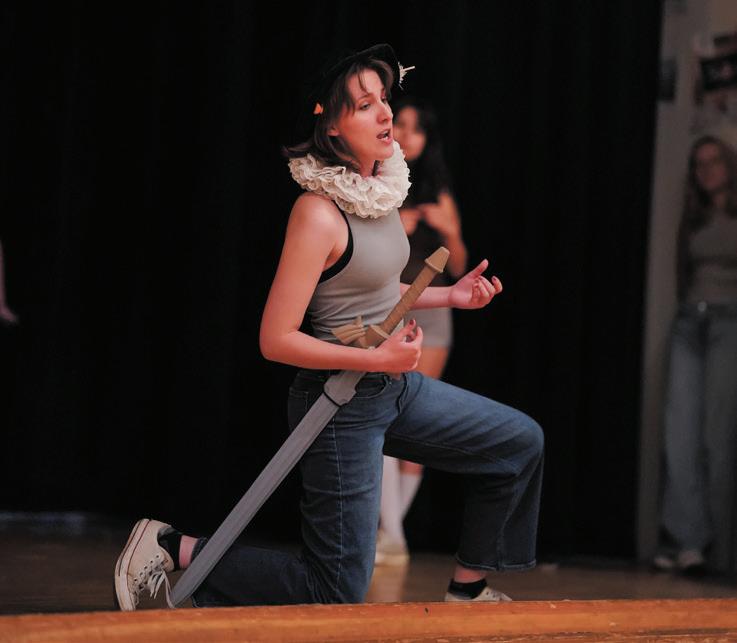
nization mainly relies on funding from ASUO as all shows are free, but donations are appreciated.
Since 2023, Villard Hall, the original location of The Pocket Playhouse, has been closed for construction, and the theater has since moved to Agate Hall on Agate Street across from Hayward Field. “The move to Agate Hall definitely created some challenges,” Shoup said. She joined the group in her freshman year, and since then she has been acting as well as working on administration.
Agate Hall is located on the opposite side of campus from Villard Hall, which Shoup said made it harder to attract large audiences. Then, Shoup and her colleague came up with a strategy to advertise the show to residence halls, which brought new audiences to Agate Hall.
Shoup and Logan Love co-directed “Sorority House of the Dead” earlier this year, breaking the record for the number of audience members in attendance. Agate Hall has more space than Villard Hall, and the audience has been growing. Shoup said that audiences for the shows tend to consist of students and some community members and families.
“We need people to come,” Shoup said. “Tell us that you are interested in what we are doing because that really helps us figure out what the community likes.”
“The Actor Games” will be at Agate Hall on May 2 and 3. The show will run for about 45 minutes and will be free for all audience members.
( ABOVE) Carina Bellendaine, who plays Shakespeare, acts out their commercial for toothpaste during a Actors Games performance at The Pocket Playhouse on May 23, 2025.
( BELOW ) The Host introduces Commedia Dell’arte played by Chase Powers.
(Eddie Bruning/Emerald)
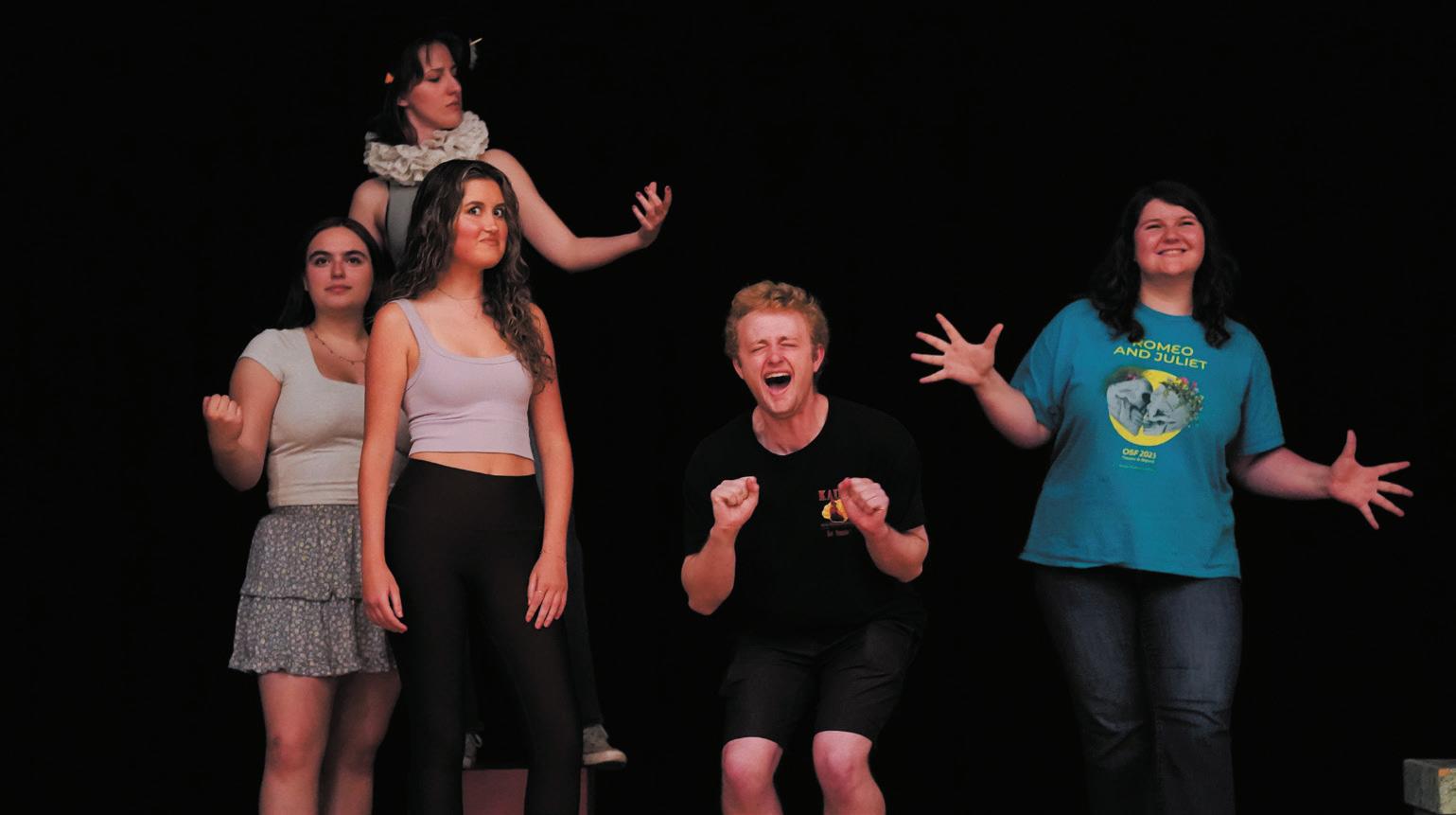

fessor Gordon Abner, who has studied police accreditation, offered more critical remarks on the composition of NWAA’s board. While Abner said NWAA’s accreditation “is better than no accreditation at all,” he cautioned that the lack of non-law enforcement voting board members impacts the rigor and neutrality of the accreditation process.
Eugene Police Chief Chris Skinner said he doesn’t have any concerns with the current composition of NWAA’s board and its ability to remain impartial when voting on the accreditation of police agencies.
When presented with Professor Abner’s suggestion to add more independent voices to the board, Skinner said that he’s open to the idea.
“If NWAA wants to do that, we would welcome it … We have so many layers of oversight here that it would be normal for us ... I don’t think it would be met with any resistance,” Skinner said.
NWAA and CALEA Differences
CALEA has a much broader reach than the NWAA nationwide. According to the CALEA, approximately 35% of law enforcement officers in the United States worked for a CALEA-accredited agency in 2023.
As of mid-April 2025, CALEA has fully accredited three police agencies in Oregon, far fewer than the 60 police agencies that the NWAA currently accredits.
There are, however, key differences between the NWAA’s and CALEA’s accreditation processes. One difference is that the accreditation process includes a public comment period. Another difference is the timeframe: agencies in CALEA must be re-accredited every four years to keep their accreditation, while agencies in NWAA must be re-accredited every three years.
When asked if there should be public comment during the accreditation process, Eugene Police Chief Skinner said he “doesn’t know” if there should be one or not.
“It’s always a bit of a slippery slope when you start asking people to give you public comment around mostly operational aspects that they have no foundational understanding of,” Skinner said.
CALEA and the NWAA also vary in costs. For an agency like the Eugene Police Department with more than 200 sworn officers and 137 civilian staff, accreditation with CALEA currently costs $16,125 initially (this does not include on-site assessment fees, which can vary) and $5,000 annually in continuation fees. NWAA’s current fees, by comparison, currently cost an agency like Eugene between $4,483 and $5,503 per year.
Inside NWAA’s Accreditation System
To remain accredited, NWAA agencies must undergo the accreditation process every three years. The process begins with the agency completing a self-assessment, in which the agency determines its level of compliance with the NWAA’s standards.
Following that process, one or more of the NWAA’s assessors will conduct an onsite review of the agency to ensure that its policies, procedures and practices meet the accreditation standards. After the onsite review, a final report is made and forwarded to the NWAA’s board for review and final approval.
Eugene Police Department’s final report is not currently publicly available on the department’s website
Eugene Police Chief Skinner said that he was not aware that the department’s final accreditation report wasn’t publicly available.
“What this process does is it brings everything to the forefront to be taken a look at,” Skinner said.
Through the recent re-accreditation process, two Eugene Police policies were updated, according to the department’s NWAA final report. One policy update clarified that firearms proficiency training must be conducted under the supervision of a “certified” range master.
Benefits to the Eugene Community
Ultimately, Eugene Police Chief Skinner believes that NWAA accreditation demonstrates to the Eugene community that the department is a “contemporary, innovative and 21st-century policing agency” that is open to outside review.
“I’m hoping what it does is that it fosters a higher level of trust and confidence in us,” Skinner said.

By Brady Ruth Sports Editor
He’s not on any award watch lists. He’s not the first name broadcasters mention when talking about Oregon’s star-studded lineup. He’s not going to lead the team in extra-base hits. But every team should get itself a Ryan Cooney.
The Ducks’ second baseman isn’t jumping off the statsheet or turning heads at PK Park, but that’s not his game. He’s incredibly self-aware of the strengths he has that led Oregon head coach Mark Wasikowski to call Cooney an MVP of the squad.
Near the bottom of the lineup, tucked behind huge names like Mason Neville, Jacob Walsh and Maddox Molony sits Cooney. A true team player, plus-300 hitter, steal threat, runs batted in (RBI) machine and maybe the tough-

“Just a very good baseball player,” Wasikowski said. “Heady, solid, team-leader, you know, can’t say enough
As of April 21, Cooney leads the team in sacrifice flies (six) and stolen bases (10) despite being seventh in at-bats (117). His 32 RBIs are the fourth-highest on the squad, an impressive mark coming from the Ducks’ eight-hole hitter. He’s maximizing his opportunities at an incredibly effective
“It’s everything to be honest,” Cooney said of his ability to be a tough out. “It’s something I’ve had my identity in my entire career and I think — especially the spot I’m in in the
Oh, and he’s one of seven players to be hitting over .300.
“He’s a good one,” Wasikowski said. “Although we’ve got a guy maybe leading (the country in home runs) and all that, Ryan could make an argument for being the MVP of
A Portland, Oregon, native, Cooney grew up with Duck ties that led to him getting recruited to play at PK Park.
“It’s really special to me,” Cooney said. “My parents went to school here and we’ve been Duck fans my entire life. To be able to be out there and having them watch, it’s really
He’s making the Cooney name proud in Eugene. He’s solidified himself as the Ducks’ everyday second basemen on a team that entered the season with seemingly countless middle-infield options. Even when Drew Smith — someone who likely started the season as Cooney’s biggest competition at second base — returned from injury, he found his new spot
in Oregon’s lineup in right field.
“Everyone has their strengths,” Cooney said. “Maybe I’m not going to be the guy that’s going to blow the game open with a home run, but I’m always going to be there and the guys know I’ve got their backs.”
That’s exactly what Cooney’s identity on the Ducks is: a team player and a clubhouse guy.
He was an occasional pawn in the chess match of Oregon’s 2024 season. He only tallied 79 at-bats across 22 appearances and he struggled, only hitting .203 and tallying more strikeouts (22) than hits (16). Still, it was seen by Cooney as a season of growth.
“Being able to recognize my strengths,” Cooney said of his freshman-year growth. “Being able to play defense a lot last year and recognizing that I’m lock-down out there and improving what I was weak on, which was obviously striking out and the slopes of hitting.”
He saw the opportunity to make an impact on the 2025 roster and jumped at the bit.
“So, I just focused on where I was weak in the offseason and worked from there,” Cooney said. “My approach is something I really wanted to work on. Taking the team atbats. More walks, more sac-flies. Doing what the situation’s calling for.”
2024 did more than bring him some self-awareness. It gave him experience, something just as valuable in college athletics. He was a factor of a team that made an NCAA Super Regional for a second-straight season.
While a third trip to the Super Regionals — and then moving on to Omaha — is the expectation for this year’s Oregon team, Cooney doesn’t see it as a daunting prospect. According to him, it’s not hard to grasp the idea of getting back again this year.
“I honestly think it’s easier, personally,” Cooney said. “Our team is very talented and we’ve got great coaching, so I think, yes, it’s an expectation, but it’s one that we have the ability to meet and we’re all working hard to get there.” In the meantime, Cooney will continue to produce from the eight-hole in the Oregon lineup. He and third baseman Carter Garate have found a pattern of success turning the lineup over and getting on base for the power hitters in the Ducks’ order.
They call themselves the “eight nine merchants,” as they ensure that there is no weak spot in Oregon’s 2025 lineup.
“It’s just a funny name we came up with,” Cooney said. “Just a way for us to fire each other up and keep going and turn it over for guys like Mason (Neville) and Dom (Hellman).”
Call it whatever you want, but call it productive.
There’s another thing that distinguishes Cooney from his teammates: his smile. All throughout warmups, batting practices and media availabilities, Cooney’s smile and energy never lack. It’s another key trait for a clubhouse leader to have, and Cooney’s certainly had plenty of successes to
My parents went to school here and we’ve been Duck fans my entire life.
To be able to be out there and having them watch, it’s really special.
- Ryan Cooney, Second Baseman
smile about in 2025.
“Baseball’s a really negative sport at times,” Cooney said. “Just inherently. And for me, being able to smile and laugh is what keeps me focused but also enjoying that I’m play ing a kids game at the same time. It’s really nice just to keep that positive attitude.”
But where does the most joy come from? In true team-player fashion, Cooney says he has the most fun watching his guys get out and compete.
“For me, I think it’s honestly watching other guys play,” Cooney said. “Watching Mason and Jacob (Walsh) and Dom and Chase (Meggers) play and being a part of that team is really what’s the most fun for me.”
Who wouldn’t want a guy like that on their team, especially with the kind of numbers he’s producing game-in and game-out?
Wasikowski certainly has found his second baseman for years to come, and Cooney’s already demonstrating traits that’ll help him continue to be a leader, team player and clubhouse guy as Oregon’s stock — along with his own — continues to grow.

RBIRuns batted in counts the number of times a batter has made it possible for a teammate to score a run.
Indicates that a player gets a hit in 30% of their at-bats. This is a significant number that often signifies a high-performing hitter.
A player very likely to steal a base when up to bat.
Field Percentage represents the amount of times a player makes a defensive play without committing an error.

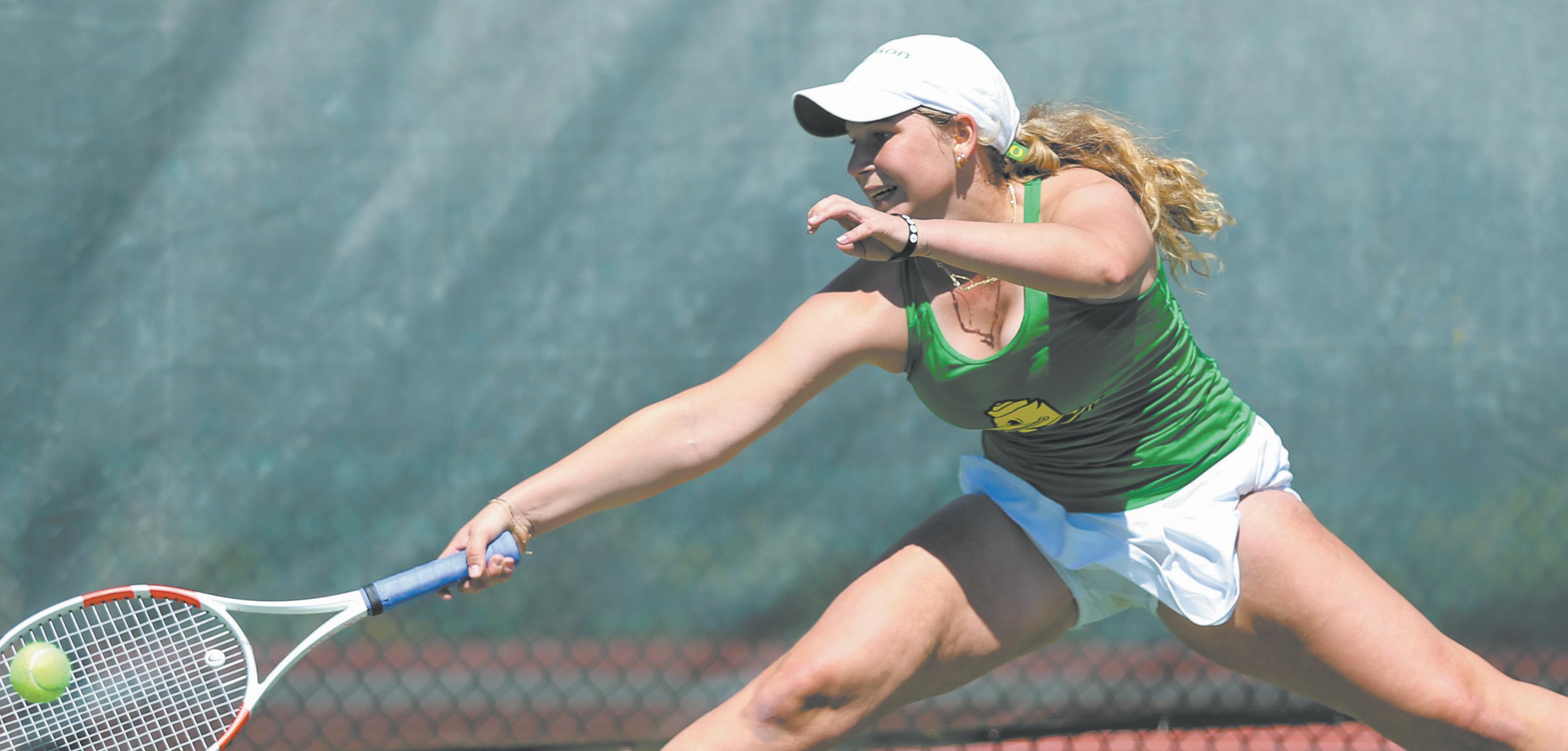
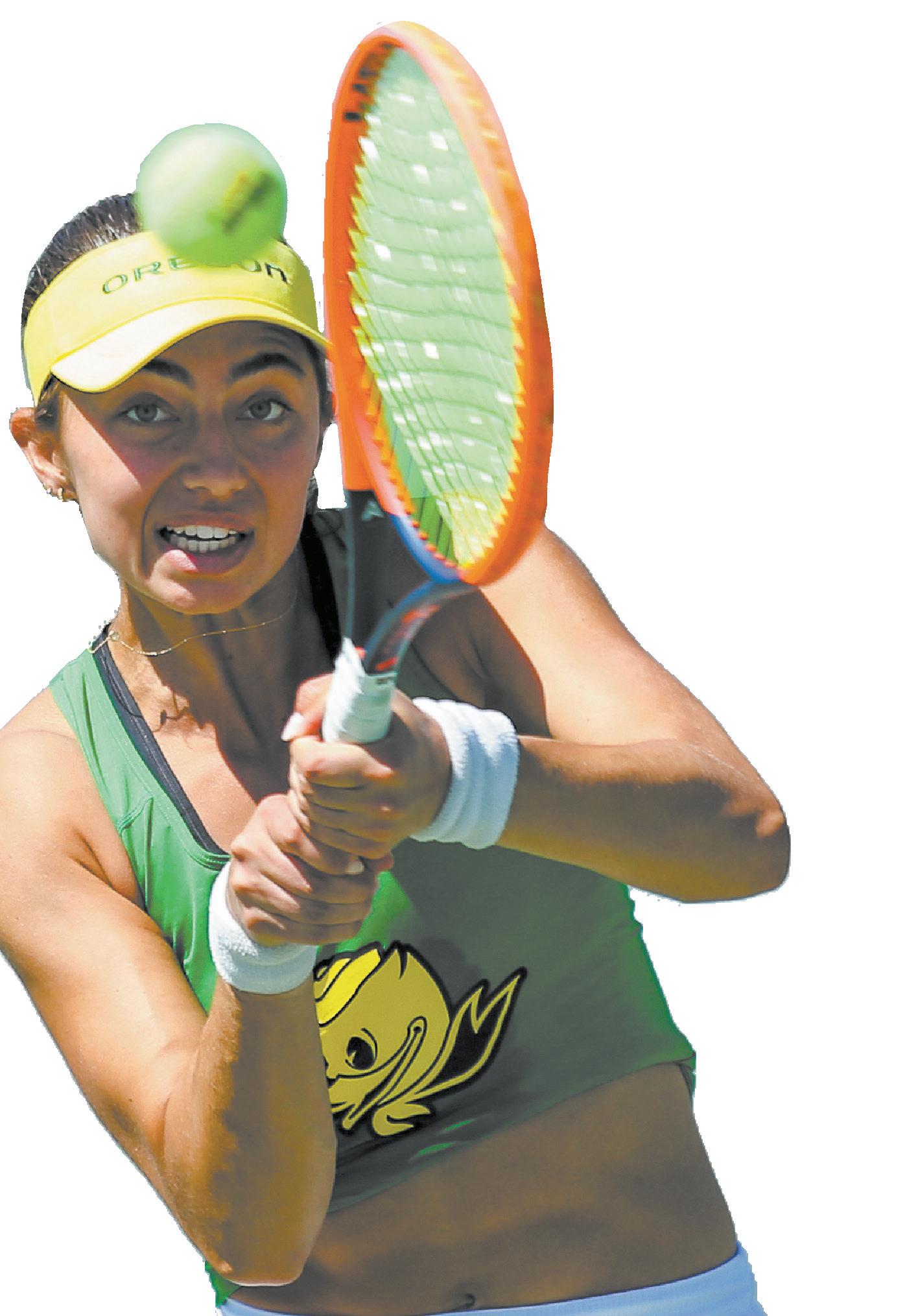



The University of Oregon’s faculty union has settled its new contract, but students shouldn’t tune out the United Academics Union’s ongoing efforts for fair pay and better working conditions.
By Maddox Brewer Knight Opinion Columnist
Like many students, I woke up the first morning of spring term unsure of whether or not I would have class that day, or even that week. When I checked my phone, my email had been flooded with notifications: the strike was off.
On May 30, the University of Oregon administration and the United Academics union, which represents UO faculty members, reached a tentative contract agreement. This agreement concluded 14 tense months of bargaining, proposals and counter-proposals.
The conclusion arrived in a nick of time — the union was poised to strike just 14 hours later, an act which would have delayed the beginning of spring term.
Students and faculty alike have expressed relief that the new contract has allowed campus life to continue as usual.
“Frankly, I’m a little relieved that the strike is not going to proceed, because strikes are always risky,” Molly Hatay, a career instructor of English and an active member of the UA, said. “They’re calculated moves that unions can use to try and achieve their goals, but even in legally protected strikes, people can become very nervous.”
“I was very relieved that the strike didn’t happen, because I was worried that it would impact students’ learning,” Ella Kuhn, a sophomore at UO, said.
I felt a similar sense of reassurance, as I worried that delaying classes would complicate my jam-packed graduation plan.
The recently ratified Collective Bargaining Agreement represents significant progress for the faculty, particularly in the non-financial
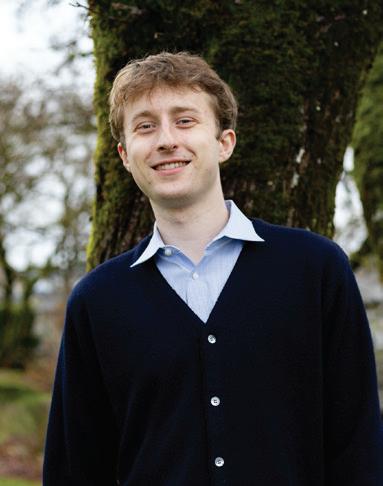
Leo is an opinion columnist for the Daily Emerald. He is a third-year student studying journalism and Spanish. Leo enjoys writing about many topics, but fashion and social media are his favorites.
elements of the contract.
“The pay has slightly improved. It’s not as big as the union was hoping for, but it is an improvement,” Hatay said.
The main improvement she cited, however, was not related to pay, but instead a matter of respect. “There are also some smaller wins in the contract, things like naming conventions,” said Hatay.
Hatay explained, “There are all different tiers of teachers at UO. Some, like pro-tem or career instructors, teach classes and have fantastic credentials, but they don’t make fantastic salaries. One win that is surprisingly meaningful to me is that there are changes to naming conventions that mean people will be able to call themselves ‘teaching professors’ instead of things like ‘career faculty.’”
Such a simple switch can bring tangible benefits. “While this doesn’t necessarily change their job description, this does make their work legible to other institutions, so when they do things like apply for grants, the labor that they’re doing for UO is valued as the work of a professor, something they’ve spent years to achieve,” Hatay said.
While the administration more readily agreed to these non-economic changes on May 29, the issue of pay proved a major hurdle. The new contract promises a 4.5% pay raise across the board during the first year, starkly lower than the UA’s desired 8.5% increase. During the second and third years, faculty will receive different pay raises based on their role.
“I think the scheduled pay increases are a big win, since the university is tasked with educating students. Part of that is being able to draw and keep fantastic faculty, and to do that they
It is impossible to make the right choices all the time. Looking for a place to turn to for guidance? Give tarot cards a try.
By Leo Heffron Opinion Columnist
Tarot card readers of varying levels shuffled their customizable decks, placed them in their boxes and gave thanks to Joanna Brook, an experienced tarot card reader and the founder of Brightheart Alchemy Guides, before heading out the door of her home on a drizzly April evening.
The decks’ themes ranged from cyberpunk to medieval, drawing an equally eclectic group of people together to analyze the cards and search for answers in their lives.
Before attending this tarot card circle, I had some prior convictions about what tarot is all about. I assumed that tarot was something hippie college kids did in their free time and that there were no benefits to analyzing your life through a deck of cards.
I was surprised by how off target I was and how the experience of tarot is not limited by the card but rather enhanced by the community surrounding it.
The regulars of Brook’s tarot circle welcomed newcomers to tarot, which included me and a few others. They explained certain cards and

need a wage where they can live comfortably without having to take on part-time jobs,” Hatay said.
However, there is still more progress to be made. The current contract lasts until June 30, 2027, but this does not mean that UA will lie dormant until the next bargaining cycle begins.
Currently,UA is engaging in other important work around campus, such as hosting caucuses. According to the UA website, upcoming caucuses will provide spaces for groups such as international faculty, faculty of color and LGBTQ+ faculty to discuss workplace issues and build solidarity.
But if UA only exists to advocate for faculty interests, why should students care?
The answer is simple: because solidarity is invaluable. On April 28, the UO Student Workers Union filed an intent to strike. The galvanizing issue is pay — while UOSW representatives demand a minimum wage of $21 for student workers, the administration has refused to budge from a minimum of $15.15.
The UA has demonstrated support for the UOSW as they prepare for their strike, as evidenced by posts on their Instagram. For the many student workers at the University of Oregon who currently feel disenfranchised by their low pay, finding allies among the faculty and communicating across unions can make their ranks stronger.
I suggest that all students, especially student workers, stay tuned in to UA updates. In a time where division is growing nationwide and both universities and state institutions face drastic changes, solidarity and unity are more important than ever.
advised on the issue in question.
Brook began her tarot journey 23 years ago in Ann Arbor, Michigan, and felt drawn to tarot due to out-of-the-ordinary experiences.
“I was picking up on emotions, and I could tell they weren’t mine,” Brook said. “I would be in a crowd of people, and emotions would just swirl past me, and that’s when I stumbled upon a sign for tarot reading classes.”
With a degree in English literature and creative writing, Brook views tarot as a medium of storytelling.
With many ways to arrange the cards, Brook says that there are “an infinite number of stories to tell, depending on what cards you put in what position.”
She’s very correct.
There are 78 cards in a tarot deck, which are divided into two sections. The Major Arcana consists of 22 cards that give you information on major life events.
The Minor Arcana covers the remaining 56 cards, which deal with more day-to-day issues.
The Minor Arcana cards are then divided into four suits: cups, swords, wands and pentacles.

Brewer
is an opinion columnist at the Daily Emerald. She is a second-year CHC student pursuing a double major in English and Spanish and a minor in linguistics. As a lifelong Oregonian, Maddox cares deeply about confronting social issues both within UO and in the greater community to make our home region a better environment for all.

Each suit is numbered one through 10 and has four court cards: the page, knight, king and queen. These are the typical parameters of a tarot deck; however, as I mentioned, decks are
completely customizable, and certain decks have different names for suit and Major Arcana cards. There are so many different ways to interpret the meaning of each card that a different story
As members of the Tarot circle asked questions to the cards and the group, it became apparent that besides guidance from the cards,
It seemed like circle members walked away with a weight off of their shoulders, more sure of what they had to accomplish in the next week, month or
Elvie Pelayo, an office manager at the University of Oregon, is only just starting to dive into the tarot world but had a lot to say about its benefits.
“Tarot helps me choose what I should do when I’ve got turmoil in my life,” Pelayo said. “It clears things up for me.” For those contemplating life and wondering what their next move should be, I would encourage exploring the Tarot
“We’re all searching for meaning,” Brook said. “There is so much going on in the world that is frightening and out of our control.”
Brook’s words stayed with me after my introduction to Tarot. In a world full of uncertainty, sometimes all we need is a new perspective on the same old questions — and a community to remind us that we are not alone.









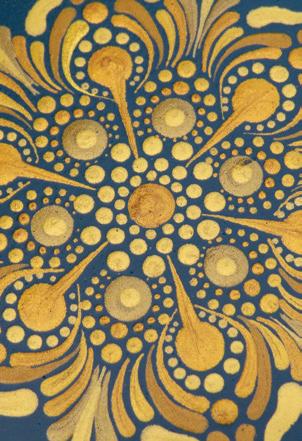






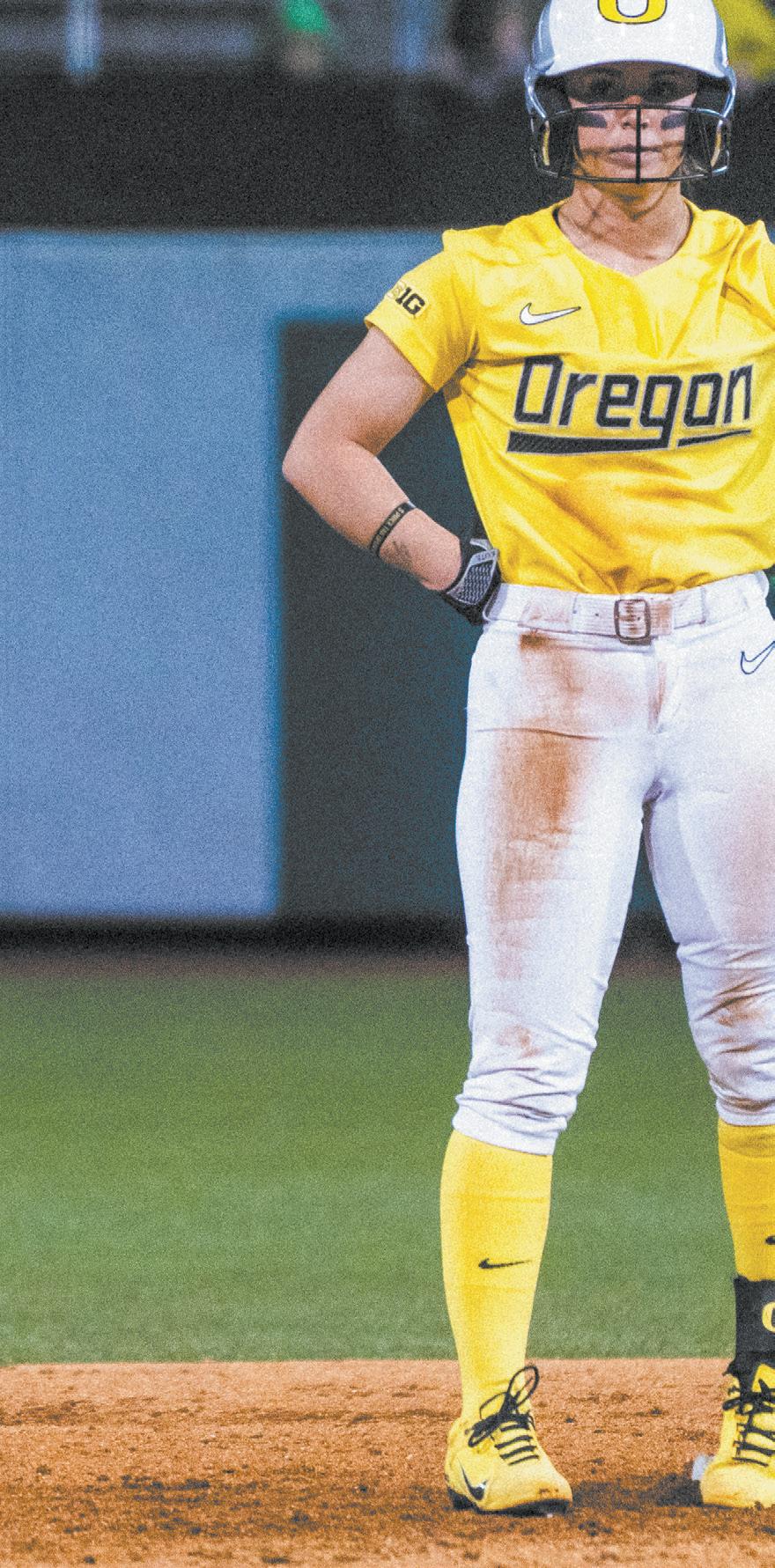

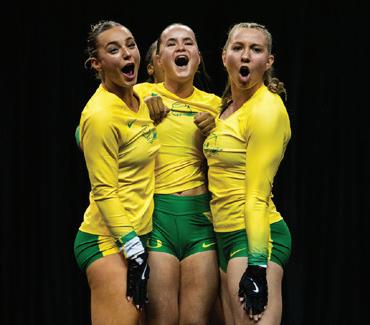

April 29,
Oregon vs. Oregon State
Jones’ three-run homer helped propel Oregon softball to a series win over UCLA
Kaylynn Jones had not hit a home run in her previous 119 collegiate at-bats.
Instead, she waited until an appearance against Oregon’s fiercest opponent to get her first.
Jones hit her first homer in the bottom of the fourth in Oregon’s 9-0 run-rule win over UCLA. After Ayanna Shaw and Katie Flannery both reached base, Jones slapped a ball to right-center that carried out for a three-run homer and extended the lead to seven.
With an easy swing on a middle-middle fastball in the fourth inning, Jones broke open Oregon’s biggest game of the season to date.
“It was great,” Jones said. “I was just trying to focus on a sac fly, trying to score our runners and just to have that feeling of hitting it out felt great.”
Jones is hitting .300 on the season — one of nine Ducks hitting at or above that number — while adding stout defense. Home runs are not why the Ducks long coveted Jones in high school at Denton Guyer High School. Home runs were not one of the primary factors they thought they were
Oregon track and field stars have the “relaxation”
competing at Hayward this outdoor season
By Lily Crane Sports Reporter
The stadium lights illuminated Hayward Field. Fans filed into the green seats in the stadium; their cheers grew louder whenever the public address announcer named University of Oregon competitors.
The home fans helped fuel distance runner Klaudia Kazimierska’s final push in her 800-meter and 1500-meter first-place finishes, as well as Silan Ayyildiz and Matthew Erickson in their successful races later in the weekend.
“When my name was announced, I felt like everybody was screaming,” Kazimierska said. “My friends are here. My mentor is here, and lots of friends just from Eugene.”
Track and field is officially back in Eugene. The Ducks returned to their home stadium on April 18 and 19 for the Oregon Open and Oregon Team Invitational.
Ayyildiz, a junior distance runner, entered the outdoor season off of a historic indoor season. She shattered the NCAA record in the mile and won the 5000-meter Big Ten title. Still, Ayyildiz said she felt “nervous” heading into the 800-meter at the Oregon Team Invitational, saying she was getting used to the speed. “I think it’s good practice to run a home
meet,” Ayyildiz said, noting that her home is about a two-minute walk from the stadium. “I was like, I don’t know what to do today. I was just waiting all day for (the race).”
The Big Ten indoor champion ended up recording a lifetime best of 2:03.11 in her first competition of the season in front of her home crowd.
Oregon track and field athletes get to spend a lot of time at Hayward this season. They’ll return for the Oregon Twilight on May 9, and then Eugene will host the Big Ten Championships for the first time at the end of May and the NCAA Championships in June.
“Having that home-field advantage gives us a lot of confidence,” Erickson, a middle-distance runner, said. “I’m comfortable in this environment. I have warm-up loops I’ve been warming up on for four years now. Just the spots in and around Eugene, my friends and family are usually at these meets. It just feels like home, and so I take some confidence. There’s a relaxation there.”
acquiring when the freshman made her Ducks debut on opening day.
Her positional versatility, contact-hitting abilities and Gold Glove-caliber defense across the diamond are what the program valued most when she committed. Plays like on Sunday when Jones fielded a ground ball from her second base position, tagged the runner that was at first and threw out the batter were what head coach Melyssa Lombardi expected — now the untapped power is just a bonus.
“Kaylynn is a gritty, fearless competitor. She knows how to handle pressure and perform in the biggest moment,” Lombardi said of Jones in a press release when she committed to Oregon. “Her softball IQ is off the charts. She has the ability to hit the ball for power and drive in runs. With her speed, she has the ability to turn singles into doubles. Her athleticism gives her the ability to play up the middle and in the outfield and she will be a fan favorite at The Jane.”
“We knew she had that power … we were waiting for it,” outfielder Kedre Luschar said of Jones after the game.
Jones’ breakout campaign has been one of the many storylines of Oregon’s remarkable 2025. Now, with Oregon’s postseason campaign two weeks away, she’s finding her power at just the right time.

1 Bank lobby conveniences
5 Hot under the collar 9 Gets ready, briefly
Swat (away)
“__ further reflection ... ”
Fertile desert spot
*Defiantly petty retaliation
Big name in blenders
Amount of food consumed
*Purchase when planning a train tour
Pros with strong opinions on style
Company abbr.
*Figure used for counting
Writer/actress Fey
__ sum: bite-sized Chinese fare
Close tightly
Getting on in years
Indent key
Personal blurbs
*Wrecking ball swingers on a construction site
Reggae kin
Post-dubbing title 52 *Ride the waves using wind power 57 Evening party 62 “Know what __?”
63 Morning person, or a feature of the answer to each starred clue? 65 Rodeo rope 66 Highest sudoku digit 67 “If all __ fails ... ” 68 Group of eight
Cafeteria carrier
Adolescent
Insincere compliments 42 Dorothy who was in many Hope/ Crosby “Road” films 44 Heat in the microwave
1 Italian region known for wine 2 __ Mints: Girl Scout Cookies choice 3 Big name in applesauce 4 Spot for a catnap 5 Casual response to “You handled it?” 6 Choose (to)
7 Lion’s sound 8 Involve 9 Game sticks that are treated with chalk
10 Quality of a scratchy voice 11 “¿Cómo __ usted?”
12 Many Thanksgiving desserts
13 Former geopolitical states: Abbr.
18 Signed off on 22 Quaint hotels
24 Tantrum
26 “Close, but no __!”
27 Jung’s inner self
28 Rambled for a while
29 “You continue to __ me!”
30 Cha-cha kin
31 Selma of “Legally Blonde”
32 Capital of Italy?
33 Tachometer stats
34 Powdery mineral
38 “So much for that”
40 Taverns
43 Big name in media streaming
45 Tie pattern
48 Mom or pop
49 City on the Hudson in upstate New York 52 Metric weight 53 Apple desktop
Exam
55 Relax, as restrictions 56 Mediocre 58 “Yeah, right” 59 Work (up) 60 Celtic language
Utopia
Genetic messenger

